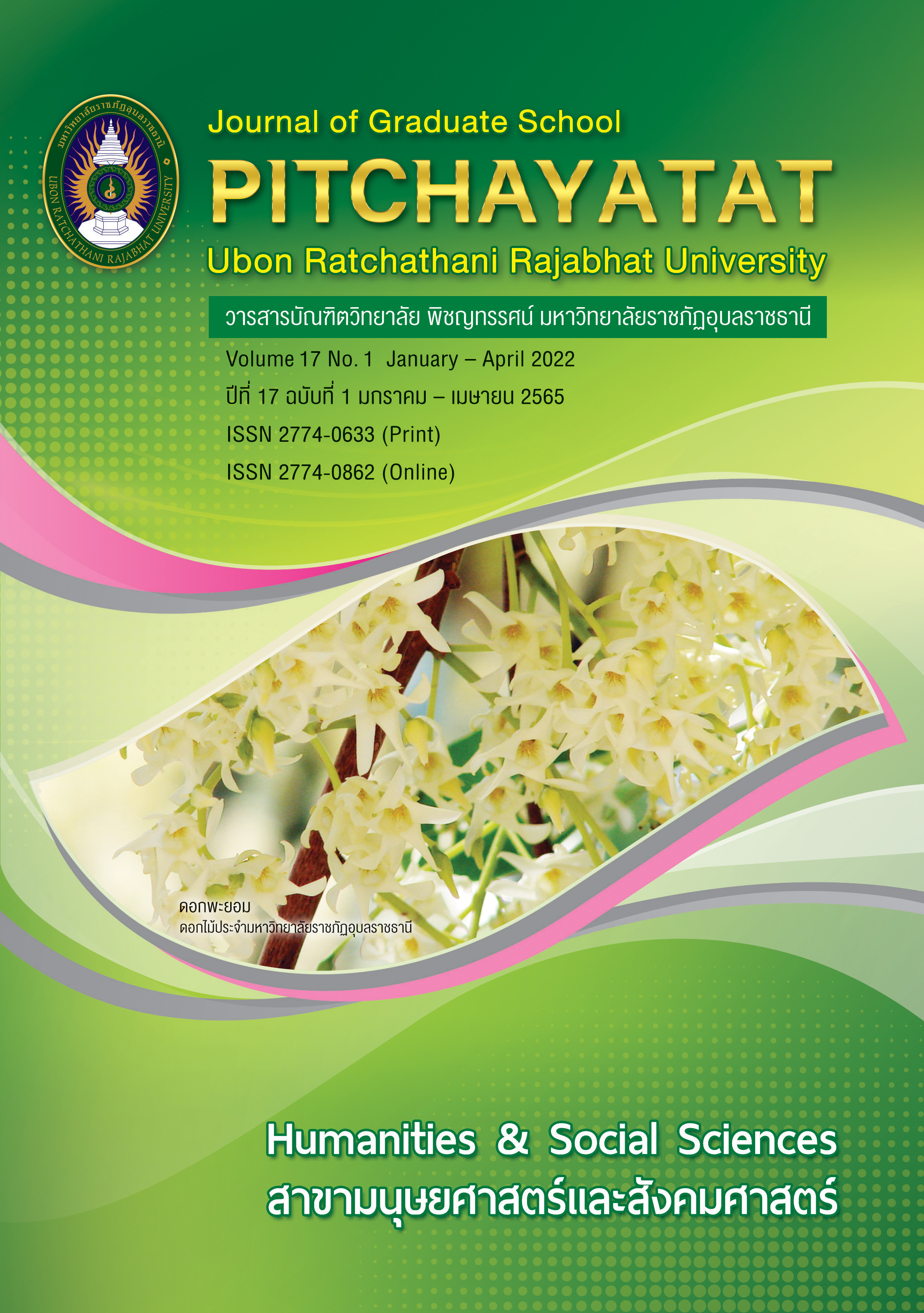ความสัมพันธ์ระหว่างการบริหารคุณภาพทั่วทั้งองค์การกับประสิทธิผลของสถานศึกษา สังกัดสำนักงานเขตพื้นที่การศึกษาประถมศึกษาสุรินทร์ เขต 3
คำสำคัญ:
การบริหารคุณภาพทั่วทั้งองค์การ, ประสิทธิผลของสถานศึกษาบทคัดย่อ
การวิจัยนี้มีวัตถุประสงค์เพื่อ 1) ศึกษาระดับการบริหารคุณภาพทั่วทั้งองค์การของสถานศึกษา สังกัดสำนักงานเขตพื้นที่การศึกษาประถมศึกษาสุรินทร์ เขต 3 2) ศึกษาระดับประสิทธิผลของสถานศึกษา สังกัดสำนักงานเขตพื้นที่การศึกษาประถมศึกษาสุรินทร์ เขต 3 และ3) ศึกษาความสัมพันธ์ระหว่างการบริหารคุณภาพทั่วทั้งองค์การกับประสิทธิผลของสถานศึกษา สังกัดสำนักงานเขตพื้นที่การศึกษาประถมศึกษาสุรินทร์ เขต 3 ตัวอย่างที่ใช้ในการวิจัยครั้งนี้ คือ ผู้บริหารสถานศึกษา จำนวน 152 คน และครูผู้สอนจำนวน 338 คน ได้มาโดยการสุ่มตัวอย่างแบบแบ่งชั้นภูมิตามสัดส่วน เครื่องมือที่ใช้ได้แก่ แบบสอบถามมาตราส่วนประมาณค่า 5 ระดับ มีค่าความเชื่อมั่นของแบบสอบถามเท่ากับ .96 สถิติที่ใช้ ได้แก่ ร้อยละ ค่าเฉลี่ย ส่วนเบี่ยงเบนมาตรฐาน และการวิเคราะห์ค่าสัมประสิทธิ์สหสัมพันธ์แบบเพียร์สัน
ผลการวิจัยพบว่า
- ระดับการบริหารคุณภาพทั่วทั้งองค์การของสถานศึกษา โดยภาพรวมและรายด้านอยู่ในระดับมาก (= 4.36) ตามลำดับ คือ ด้านการทำงานเป็นทีม ด้านการติดต่อสื่อสาร ด้านการวัดผลการปฏิบัติงาน ด้านภาวะผู้นำ ด้านโครงสร้างองค์การที่เกื้อหนุน ด้านการให้รางวัลและการยอมรับ และด้านการศึกษาและการอบรม
- ระดับประสิทธิผลของสถานศึกษา โดยภาพรวมและรายด้านอยู่ในระดับมาก ตามลำดับค่าเฉลี่ย คือ ด้านความพึงพอใจในการทำงานของครู ด้านความสามารถในการปรับตัวต่อสภาพแวดล้อมที่มากระทบทั้งภายในและภายนอก ด้านความสามารถในการผลิตนักเรียนที่มีผลสัมฤทธิ์ทางการเรียนสูง และด้านความสามารถในการใช้สื่อนวัตกรรมและเทคโนโลยีของครู
- ความสัมพันธ์ระหว่างการบริหารคุณภาพทั่วทั้งองค์การกับประสิทธิผลของสถานศึกษามีความสัมพันธ์กันทางบวก และมีความสัมพันธ์กันในระดับสูงอย่างมีนัยสำคัญทางสถิติที่ระดับ .01
เอกสารอ้างอิง
กลุ่มนโยบายและแผน. แผนพัฒนาการศึกษาขั้นพื้นฐาน. (ออนไลน์) 2562 (อ้างเมื่อ 3 มิถุนายน 2562). จากhttp://www.surin3.go.th
กนกทิพย์ ดอกลัดดา. ความสัมพันธ์ระหว่างการบริหารสถานศึกษากับประสิทธิผลสถานศึกษาของโรงเรียนราช
วินิตบางแก้ว สังกัดสำนักงานเขตพื้นที่การศึกษามัธยมศึกษา เขต 6. วิทยานิพนธ์ศึกษาศาสตรมหาบัณฑิต สาขาวิชาการบริหารการศึกษา มหาวิทยาลัยบูรพา, 2560.
งามตา ธานีวรรณ. ปัจจัยที่ส่งผลต่อประสิทธิผลของโรงเรียนสังกัดสำนักงานเขตพื้นที่การศึกษายโสธร. วิทยานิพนธ์ศึกษาศาสตรมหาบัณฑิต สาขาวิชาการบริหารการศึกษา มหาวิทยาลัยบูรพา, 2553.
ทิพวรรณ สำเภาแก้ว. ปัจจัยการบริหารที่ส่งผลต่อประสิทธิผลของสถานศึกษา สังกัดสำนักงานเขตพื้นที่การศึกษา
ประถมศึกษา สระบุรีแก้ว เขต 2. วิทยานิพนธ์ครุศาสตรมหาบัณฑิต สาขาวิชาการบริหารการศึกษา
มหาวิทยาลัยราชภัฏราชนครินทร์, 2560.
บรรจง เจริญสุข. ความสัมพันธ์ระหว่างการบริหารตามหลักธรรมาภิบาลของผู้บริหารสถานศึกษากับประสิทธิผลของ
สถานศึกษา สังกัดสำนักงานเขตพื้นที่การศึกษาประถมศึกษาสุราษฎร์ธานี เขต 3. วิทยานิพนธ์ศึกษาศาสตรมหาบัณฑิต มหาวิทยาลัยรามคำแหง, 2561.
ประจักษ์ ชูศร. “ปัจจัยการจัดการคุณภาพโดยรวมที่ส่งผลต่อประสิทธิผลของโรงเรียนอนุบาลประจำจังหวัดชายแดนภาคใต้,” วารสารบริหารการศึกษา มศว. 16, 30 (มกราคม-มิถุนายน 2562): 76-88.
พวงรัตน์ ทวีรัตน์. วิธีการวิจัยทางพฤติกรรมศาสตร์และสังคมศาสตร์. พิมพ์ครั้งที่ 8. กรุงเทพฯ: สำนักทดสอบทางการศึกษาและจิตวิทยา มหาวิทยาลัยศรีนครินทรวิโรฒประสานมิตร, 2543.
ภารดี อนันต์นาวี. หลักการ แนวคิด ทฤษฎีทางการบริหารการศึกษา. ชลบุรี: มนตรี, 2553.
รัตนาภรณ์ รักษ์ตัว. “การบริหารคุณภาพทั่วทั้งองค์กรในสถานศึกษาตาม ความคิดเห็นของผู้บริหารและครูผู้สอนใน
สถานศึกษา สังกัดสำนักงานเขตพื้นที่การศึกษามัธยมศึกษาเขต 8,” Journal of Humanities and Social
Sciences, Suan Sunandha Rajabhat University. 2, 2 (กรกฎาคม-ธันวาคม 2562): 73-87.
เลขาธิการสภาการศึกษา, สำนักงาน แผนการศึกษาแห่งชาติ พ.ศ. 2560–2579. กรุงเทพฯ: บริษัทพริกหวาน
กราฟฟิค, 2560.
เลขาธิการสภาผู้แทนราษฎร, สำนักงาน รัฐธรรมนูญแห่งราชอาณาจักรไทย. กรุงเทพฯ: สำนักงานเลขาธิการสภา
ผู้แทนราษฎร, 2560.
สุทิน สุขกาย. “ประสิทธิผลของสถานศึกษาสังกัดสำนักงานเขตพื้นที่การศึกษาประถมศึกษาศรีสะเกษ เขต 1,”
Journal of Association of Professional Development of Educational Administration of
Thailand. 1, 1 (มกราคม-มีนาคม 2563): 69-77.
อลิษา สุคุณพันธุ์. การบริหารแบบมุ่งคุณภาพทั้งองค์การที่ส่งผลต่อประสิทธิผลของสถานศึกษา สังกัดสำนักงานเขต
พื้นที่การศึกษาประถมศึกษาจันทบุรี. วิทยานิพนธ์ครุศาสตรมหาบัณฑิต สาขาการบริหารการศึกษามหาวิทยาลัยราชภัฏรำไพพรรณ, 2555.
Avila, Lourdes B. “Total Quality Management (TQM) Practices of School Administrators in Relation to School Performance among Teacher Education Institutions in the Province of Quezon,” KnE Social Sciences. 4th International Research Conference on Higher
Education; 23-26 January 2018; Grand Ina Bali Resort and Beach Hotel, Bali, Indonesia, 2018.
pp. 879-890.
Cronbach, L.J. Essentials of Psychological Testing. 5th ed. New York: Harper Collins, 1990.
Dale, B. G. Managing Quality. 2nd ed. New Yok: Prentice Hall, 1994.
Dessler, Gray. Organization theory: Integrating structure and behavior. New Yok: Prentice-Hall,
Ferguson, G. A. Statistical Analysis in Psychology and Education. 5th ed. New Yok: McGraw–Hill,
Gibson, D. I. and, R. A. Bray. “A study and reorganization of Plagioporus Stafford, 1904 (Digenea:
Opecoelidae) and related genera, with special reference to forms from European Atlantic waters,” Journal of Natural History. 16, 4 (February 2007): 529-559.
Hannan, Michael T. and John Freeman. Structural Inertia and Organizational Change. American
Sociological Review. 49, 2 (April 1984): 149-164.
Hoy, Wayne K. and Cecil G. Miskel. Educational Administration: Theory Research and Practice. 4th ed. New Yok: Harper Collins, 1991.
Hoy, Wayne K. and FJudith Furguson. Judith. “Theoretical framework and exploration of
Organizational Effectiveness of Schools,” Texas: Business Publication. 21, 2 (September
: 117-134.
Krejcie, R. V. and D. W. Morgan. Determining Sample Size for Research Activities. Educational
and Psychological Measurement. 30, 3 (1 September 1970): 607-610.
Mott, Paul E. The characteristic of efficient organizations. New York: Harper & Row, 1972.
Prajogo, D. I. and A. S. Sohal. “Transitioning from total quality management to total innovation
management: An Australian case,” International Journal of Quality & Reliability
Management. 21, 8 (October 2004): 861-875.
Tenner, Irving R. and J. DeToro. Total Quality Management: Three Steps to Continuous
Improvement. Tamil Nadu: National Press Publications, 1992.
Usman, Nasir; A. R. “The Implementation of Total Quality Management (TQM) At National Vocational Schools (SMKS) In Aceh, Indonesia,” Talent Development & Excellence. Special issue 2s. 12, 2 (July 2020): 664-672.
Weintraub, Donald L. “Implement Total Quality Management,” Economic Development Review. 11 (April 1993): 39-42.
William, Richard L. Essentials of Total Quality Management. New Yok: American Management
Association, 1994.
ดาวน์โหลด
เผยแพร่แล้ว
รูปแบบการอ้างอิง
ฉบับ
ประเภทบทความ
สัญญาอนุญาต
ลิขสิทธิ์ (c) 2022 วารสารบัณฑิตวิทยาลัย พิชญทรรศน์ มหาวิทยาลัยราชภัฏอุบลราชธานี

อนุญาตภายใต้เงื่อนไข Creative Commons Attribution-NonCommercial-NoDerivatives 4.0 International License.
บทความทุกเรื่องได้รับการตรวจความถูกต้องทางวิชาการโดยผู้ทรงคุณวุฒิภายนอกอย่างน้อย 3 คน ความคิดเห็นในวารสารพิชญทรรศน์เป็นความคิดเห็นของผู้นิพนธ์มิใช่ความคิดเห็นของผู้จัดทำ จึงมิใช่ความรับผิดชอบของวารสารพิชญทรรศน์ และบทความในวารสารพิชญทรรศน์สงวนสิทธิ์ตามกฎหมายไทย การจะนำไปเผยแพร่ต้องได้รับอนุญาตเป็นลายลักษณ์อักษรจากกองบรรณาธิการ





